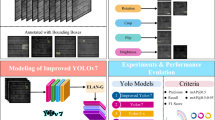Abstract
Micro-cracks on solar cells often affect the power generation efficiency, so this paper proposes a lightweight network for cell image micro-crack detection task. Firstly, a Feature Selection framework is proposed, which can efficiently and adaptively decide the number of layers of the feature extraction network, and clip unnecessary feature generation process. In addition, based on the design of the Transformer layer, Transformer Distillation is proposed. In Transformer Distillation, the designed Transformer Refine module excavates the distillation information from the two dimensions of features and relations. Using a combination of Feature Selection and Transformer Distillation, the lightweight networks based on ResNet and ViT can achieve much better effects than the original networks, with classification accuracy rates of 88.58% and 89.35% respectively.
Access this chapter
Tax calculation will be finalised at checkout
Purchases are for personal use only
Similar content being viewed by others
References
Anwar, S.A., Abdullah, M.Z.: Micro-crack detection of multicrystalline solar cells featuring an improved anisotropic diffusion filter and image segmentation technique. EURASIP J. Image Video Process. 2014, 1–17 (2014)
Buerhop-Lutz, C., et al.: A benchmark for visual identification of defective solar cells in electroluminescence imagery. In: 35th European PV Solar Energy Conference and Exhibition, vol. 12871289, pp. 1287–1289 (2018)
Deitsch, S., et al.: Segmentation of photovoltaic module cells in uncalibrated electroluminescence images. Mach. Vis. Appl. 32(4), 84 (2021)
Deitsch, S., et al.: Automatic classification of defective photovoltaic module cells in electroluminescence images. Sol. Energy 185, 455–468 (2019)
Demirci, M.Y., Beşli, N., Gümüşçü, A.: Efficient deep feature extraction and classification for identifying defective photovoltaic module cells in electroluminescence images. Expert Syst. Appl. 175, 114810 (2021)
Dosovitskiy, A., et al.: An image is worth 16x16 words: transformers for image recognition at scale. arXiv preprint arXiv:2010.11929 (2020)
Fuyuki, T., Kitiyanan, A.: Photographic diagnosis of crystalline silicon solar cells utilizing electroluminescence. Appl. Phys. A 96, 189–196 (2009)
He, K., Zhang, X., Ren, S., Sun, J.: Deep residual learning for image recognition. In: Proceedings of the IEEE Conference on Computer Vision and Pattern Recognition, pp. 770–778 (2016)
Hinton, G., Vinyals, O., Dean, J.: Distilling the knowledge in a neural network. arXiv preprint arXiv:1503.02531 (2015)
Johnston, S., et al.: Correlating multicrystalline silicon defect types using photoluminescence, defect-band emission, and lock-in thermography imaging techniques. IEEE J. Photovoltaics 4(1), 348–354 (2013)
Mirzadeh, S.I., Farajtabar, M., Li, A., Levine, N., Matsukawa, A., Ghasemzadeh, H.: Improved knowledge distillation via teacher assistant. In: Proceedings of the AAAI Conference on Artificial Intelligence, vol. 34, pp. 5191–5198 (2020)
Romero, A., Ballas, N., Kahou, S.E., Chassang, A., Gatta, C., Bengio, Y.: FitNets: hints for thin deep nets. arXiv preprint arXiv:1412.6550 (2014)
Tan, M., Le, Q.: EfficientNet: rethinking model scaling for convolutional neural networks. In: International Conference on Machine Learning, pp. 6105–6114. PMLR (2019)
Touvron, H., Cord, M., Douze, M., Massa, F., Sablayrolles, A., Jégou, H.: Training data-efficient image transformers & distillation through attention. In: International Conference on Machine Learning, pp. 10347–10357. PMLR (2021)
Tsai, D.M., Wu, S.C., Li, W.C.: Defect detection of solar cells in electroluminescence images using Fourier image reconstruction. Sol. Energy Mater. Sol. Cells 99, 250–262 (2012)
Tseng, D.C., Liu, Y.S., Chou, C.M.: Automatic finger interruption detection in electroluminescence images of multicrystalline solar cells. Math. Prob. Eng. 2015 (2015)
Zagoruyko, S., Komodakis, N.: Paying more attention to attention: improving the performance of convolutional neural networks via attention transfer. arXiv preprint arXiv:1612.03928 (2016)
Zhang, L., Song, J., Gao, A., Chen, J., Bao, C., Ma, K.: Be your own teacher: improve the performance of convolutional neural networks via self distillation. In: Proceedings of the IEEE/CVF International Conference on Computer Vision, pp. 3713–3722 (2019)
Zhang, Y., Xiang, T., Hospedales, T.M., Lu, H.: Deep mutual learning. In: Proceedings of the IEEE Conference on Computer Vision and Pattern Recognition, pp. 4320–4328 (2018)
Author information
Authors and Affiliations
Corresponding author
Editor information
Editors and Affiliations
Rights and permissions
Copyright information
© 2024 The Author(s), under exclusive license to Springer Nature Singapore Pte Ltd.
About this paper
Cite this paper
Xie, X., Liu, X., Chen, Q., Leng, B. (2024). Efficient Lightweight Network with Transformer-Based Distillation for Micro-crack Detection of Solar Cells. In: Luo, B., Cheng, L., Wu, ZG., Li, H., Li, C. (eds) Neural Information Processing. ICONIP 2023. Lecture Notes in Computer Science, vol 14449. Springer, Singapore. https://doi.org/10.1007/978-981-99-8067-3_1
Download citation
DOI: https://doi.org/10.1007/978-981-99-8067-3_1
Published:
Publisher Name: Springer, Singapore
Print ISBN: 978-981-99-8066-6
Online ISBN: 978-981-99-8067-3
eBook Packages: Computer ScienceComputer Science (R0)




